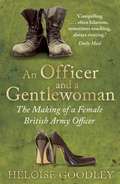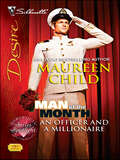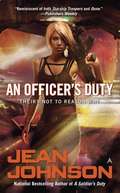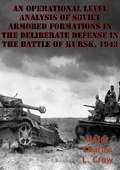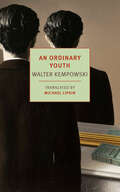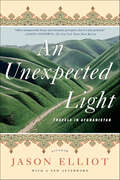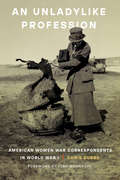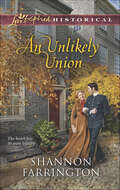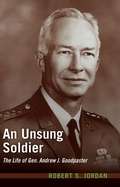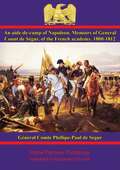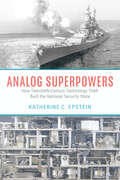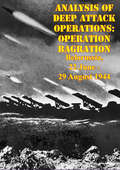- Table View
- List View
An Officer and a Fortune (The Fortunes of Texas: The Hotel Fortune #5)
by Nina CrespoHis homecoming was temporary. Until he met the woman who changed everything.Captain Collin Waldon is on leave from the military, tending to his ailing father in his final days. Knowing his stay in Rambling Rose will be short, Collin is not looking for romantic entanglements—especially not with Nicole Fortune, the beautiful, free-spirited executive chef of Roja Restaurant in the struggling Hotel Fortune. Yet these two unlikely lovers seem perfect for each other, until Collin’s reassignment threatens their newfound bliss…From Harlequin Special Edition: Believe in love. Overcome obstacles. Find happiness.The Fortunes of Texas: The Hotel FortuneBook 1: Her Texas New Year’s Wish by Michelle MajorBook 2: Their Second-Time Valentine by Helen LaceyBook 3: An Unexpected Father by Marie FerrarellaBook 4: Runaway Groom by Lynne MarshallBook 5: An Officer and a Fortune by Nina CrespoBook 6: Cowboy in Disguise by Allison Leigh
An Officer and a Gentlewoman: The Making of a Female British Army Officer
by Heloise GoodleyWhen Heloise Goodley ditched her City job and decided to attend officer training at the Royal Military Academy Sandhurst, she had no prior military experience. On her arrival she was a complete novice: she'd never fired a rifle, she couldn't march; she couldn't make her bed; she couldn't even shine her shoes.An Officer and a Gentlewoman charts Goodley's absorbing journey through Sandhurst and on to Afghanistan and gives an insight into the array of bizarre military behaviours and customs at this esoteric and hidden institution. With wit and sensitivity Goodley details her experiences as a cadet and the painful transition from civilian to soldier. Moreover, she rejects lazy preconceptions and sheds new light on what has hitherto been a bastion of maleness - the British Army.
An Officer and a Gentlewoman: The Making of a Female British Army Officer
by Héloïse GoodleyWhen Heloise Goodley ditched her City job and decided to attend officer training at the Royal Military Academy Sandhurst, she had no prior military experience. On her arrival she was a complete novice: she'd never fired a rifle, she couldn't march; she couldn't make her bed; she couldn't even shine her shoes.An Officer and a Gentlewoman charts Goodley's absorbing journey through Sandhurst and on to Afghanistan and gives an insight into the array of bizarre military behaviours and customs at this esoteric and hidden institution. With wit and sensitivity Goodley details her experiences as a cadet and the painful transition from civilian to soldier. Moreover, she rejects lazy preconceptions and sheds new light on what has hitherto been a bastion of maleness - the British Army.
An Officer and a Millionaire (Man of the Month)
by Maureen ChildMr. January: Hunter Cabot, Navy SEALVital Statistics: Tall, rich and...married?Mission: Find out who's been sleeping in his bed.The broad-shouldered military man had no patience with games. Margie-Cabot?-had to go. She'd been masquerading as his spouse for nearly a year, living in his house while he'd been overseas. Now all his skills were focused on payback: it would be sweet, swift and sexy. But first he'd have that "wedding night!"
An Officer's Duty (Theirs Not to Reason Why, Book #2)
by Jean JohnsonJean Johnson--the national bestselling author of the Sons of Destiny novels--returns to the world she introduced in A Soldier's Duty. After having a terrible vision of the future, Ia must somehow ensure the salvation of her home galaxy long after she's gone... Promoted in the field for courage and leadership under fire, Ia is now poised to become an officer in the Space Force Navy--once she undertakes her Academy training. First, however, she travels back home to Sanctuary, a heavyworld colony being torn apart by religious conflict. Ia must prepare her family and followers for the hardships they will endure in order to secure the galaxy's survival. Her assignment is to command a Blockade Patrol ship. Her goal, to save as many lives as she can. But at the Academy, she discovers an unexpected challenge: the one man who could disrupt those plans, the man whose future she cannot foresee. And time is running out for Ia, for the galaxy is on the brink of the Second of the Second Salik War...
An Operational Level Analysis Of Soviet Armored Formations In The Deliberate Defense In The Battle Of Kursk, 1943
by Major Charles L. CrowThis study is an historical analysis of the Soviet operational use of tank and mechanized corps, and tank armies, in the deliberate defense at the Battle of Kursk in 1943. It centers on the question of how effective was the Red Army in employing these units during this momentous battle. Events that shaped the battle and a brief comparison of forces set the stage. A discussion of the actual battle on the Central and Voronezh Fronts is followed by an analysis of the effectiveness of the employment of the operational armored units.The battle analysis methodology as promulgated by the Combat Studies Institute at the United States Army Command and General Staff College, Fort Leavenworth, Kansas, established the guidelines for the study. Both Western and Soviet sources were utilized. Objectivity and compatibility of all available source material were of paramount importance in establishing the validity and accuracy of various accounts.The study concludes the Soviets prepared superbly for the operational battle; however, execution fell short of expectations. Because this was the first time the Soviets used tank armies in battle, an analysis of Kursk serves as an excellent catalyst for subsequent examination of present Soviet defensive doctrine and the use of tank armies in defense.
An Ordinary Woman: An utterly captivating and uplifting story of one woman’s strength and determination…
by Susan SallisFrom the Sunday Times bestselling author Susan Sallis comes a wonderfully evocative novel, perfect for fans of Maeve Binchy, Fiona Valpy and Rosamunde Pilcher.READERS ARE LOVING AN ORDINARY WOMAN! "A remarkable story of love, life, pleasures and hazards. Strong characters who define this story. Excellent read and would strongly recommend Susan Sallis" -- 5 STARS"The storyline was captivating from the start..." - 5 STARS"This book held me from the first page to the last!" - 5 STARS"Very good story, loved every minute..." - 5 STARS***********************************************WHEN NEEDED, WILL SHE BE ABLE TO RISE TO THE CHALLENGE?1945, Connecticut. A scandal breaks which forces a baffled Rose, aged four, and her mother to leave America and return home to England.The following May, a sister is born - Joanna or 'Jon'. Rose and Jon are like chalk and cheese. Jon is vivacious, fun, impetuous, rash and persuasive. Rose is reserved, steady, sure, reliable and...ordinary. It is her lot in life to hold the family together through times of tragedy and emotional upheaval.But, when, years later, Jon sets events in motion which send Rose across the Atlantic again and into the most extraordinary event of her life, can she ever be thought of as ordinary again?
An Ordinary Youth
by Walter KempowskiAn Ordinary Youth is a novel drawn directly from the author's boyhood in Nazi Germany. Nine-year-old Walter's family is moving house when the novel opens, but Walter's main concerns are his tin soldiers and his older brother&’s jazz records, his father&’s fluctuating moods, and his mother&’s ministrations and anxieties. While Walter is absorbed by his private life, the extraordinary accumulation of contemporary idioms that accompany his point of view—dialogue, song, literary quotations, commercials, and political slogans—tell a different story. Through this echo chamber of voices, Kempowski shows a hugely turbulent and murderously intolerant nation racing toward disaster. An immediate bestseller when it was first published in Germany in 1971 (as Tadellöser & Wolff) and the best known of Kempowski's novels in Germany, An Ordinary Youth is now available in English for the first time.
An Original, Compiled, and Corrected Account of Burgoyne's Campaign: And the Memorable Battles of Bemis's Heights, Sept. 19, and October 7, 1777
by Charles NeilsonCharles Neilson’s "An Original, Compiled, and Corrected Account of Burgoyne's Campaign: And the Memorable Battles of Bemis's Heights, Sept. 19, and October 7, 1777" offers a detailed and meticulously researched chronicle of one of the most pivotal moments in the American Revolutionary War. This comprehensive work provides a vivid portrayal of General John Burgoyne’s campaign and the critical battles that culminated in the British surrender at Saratoga.Neilson’s account is distinguished by its thorough compilation and correction of contemporary sources, including official reports, personal letters, and eyewitness testimonies. His narrative begins with the strategic objectives of Burgoyne’s invasion from Canada and follows the intricate maneuvers, logistical challenges, and key engagements that defined the campaign.Central to the book are the Battles of Bemis Heights, fought on September 19 and October 7, 1777. Neilson provides a gripping and detailed analysis of these encounters, highlighting the tactical decisions, heroic actions, and intense combat that characterized these crucial confrontations. His descriptions bring to life the valor and resilience of both the American and British forces, offering readers a front-row seat to the drama and chaos of battle.Neilson’s work is more than just a military history; it captures the broader significance of Burgoyne’s campaign within the context of the Revolutionary War. He explores the strategic implications of the American victory at Saratoga, which not only marked a turning point in the conflict but also persuaded France to enter the war on the side of the American colonies, altering the course of history.Through Neilson’s detailed and compelling narrative, this book stands as a testament to the strategic brilliance and indomitable spirit that defined a critical chapter in America’s fight for independence. It remains a definitive reference on Burgoyne’s campaign and the monumental battles that shaped the outcome of the Revolutionary War.
An Unexpected Light: Travels in Afghanistan
by Jason ElliotPart historical evocation, part travelogue, and part personal quest, An Unexpected Light is the account of Elliot's journey through Afghanistan, a country considered off-limits to travelers for twenty years. Aware of the risks involved, but determined to explore what he could of the Afghan people and culture, Elliot leaves the relative security of Kabul. He travels by foot and on horseback, and hitches rides on trucks that eventually lead him into the snowbound mountains of the North toward Uzbekistan, the former battlefields of the Soviet army's "hidden war." Here the Afghan landscape kindles a recollection of the author's life ten years earlier, when he fought with the anti-Soviet mujaheddin resistance during the Soviet occupation of Afghanistan. Weaving different Afghan times and visits with revealing insights on matters ranging from antipersonnel mines to Sufism, Elliot has created a narrative mosaic of startling prose that captures perfectly the powerful allure of a seldom-glimpsed world. Jason Elliot's An Unexpected Light is a remarkable, poignant book about Afghanistan and a heartfelt reflection on the experience of travel itself.
An Unladylike Offer (The Radwells)
by Christine MerrillIn this Regency-era romance, a lady hopes to seduce a handsome stranger in order to avoid being forced to accept an arranged marriage.Miss Esme Canville’s abusive father is resolved to marry her off—but she won’t submit tamely to his decree. Instead, she’ll offer herself to notorious rake Captain St. John Radwell and enjoy all the freedom of a mistress!St. John is intent on mending his rakish ways. He won’t seduce an innocent virgin. But Esme is determined, beautiful and very, very tempting. . . .
An Unladylike Profession: American Women War Correspondents in World War I
by Chris DubbsWhen World War I began, war reporting was a thoroughly masculine bastion of journalism. But that did not stop dozens of women reporters from stepping into the breach, defying gender norms and official restrictions to establish roles for themselves—and to write new kinds of narratives about women and war. Chris Dubbs tells the fascinating stories of Edith Wharton, Nellie Bly, and more than thirty other American women who worked as war reporters. As Dubbs shows, stories by these journalists brought in women from the periphery of war and made them active participants—fully engaged and equally heroic, if bearing different burdens and making different sacrifices. Women journalists traveled from belligerent capitals to the front lines to report on the conflict. But their experiences also brought them into contact with social transformations, political unrest, labor conditions, campaigns for women&’s rights, and the rise of revolutionary socialism. An eye-opening look at women&’s war reporting, An Unladylike Profession is a portrait of a sisterhood from the guns of August to the corridors of Versailles. Purchase the audio edition.
An Unlikely Spy: A Novel
by Rebecca Starford“A beguiling tale of espionage." -- Pam Jenoff, author of The Orphans Tale and The Lost Girls of ParisA twisting, sophisticated World War II novel following a spy who goes undercover as a part of MI5—in chasing the secrets of others, how much will she lose of herself?Evelyn Varley has always been ambitious and clever. As a girl, she earned a scholarship to a prestigious academy well above her parents’ means, gaining her a best friend from one of England’s wealthiest families. In 1939, with an Oxford degree in hand and war looming, Evelyn finds herself recruited into an elite MI5 counterintelligence unit.A ruthless secret society seeks an alliance with Germany and, posing as a Nazi sympathizer, Evelyn must build a case to expose their treachery. But as she is drawn deeper into layers of duplicity—perhaps of her own making—some of those closest to her become embroiled in her investigation. With Evelyn’s loyalties placed under extraordinary pressure, she’ll face an impossible choice: save her country or the people who love her. Her decision echoes for years after the war, impacting everyone who thought they knew the real Evelyn Varley.Beguiling and dark, An Unlikely Spy is a fascinating story of deception and sacrifice, based on the history of real people within the British intelligence community.
An Unlikely Union
by Shannon FarringtonThe Doctor's Wounded Heart Union Army physician Evan Mackay runs his ward of the Baltimore military hospital with tremendous skill but no warmth. He will do his duty by the Confederate soldiers in his care, but sympathy and tenderness left him after the death of his brother, a Federal soldier. So why can't he stop himself from warming to his beautiful, compassionate, unapologetically Southern nurse? Two years of war have shown Emily Davis that the men on both sides of the war need all the comfort and care they can get. And that includes a stubborn, prickly Scottish doctor. As Evan opens his heart to Emily, she can only hope he'll let her fill it with forgiveness...and love..
An Unsung Soldier
by Robert S. JordanGen. Andrew J. Goodpaster was one of the leading soldier-scholars of his time. He was one of the key figures during the Cold War - one who stood among the dominant American military and political personalities of those times. Goodpaster served Gen. Dwight Eisenhower in establishing the international military component of NATO and then served as his Staff Secretary. He achieved the highest international military command assignment possible - as NATO's Supreme Allied Commander, Europe and restored the integrity of West Point during a major ethical crisis. Upon his final retirement and for over a quarter-century thereafter, he was actively involved both the formal and informal world of Washington policy-making, making his mark repeatedly as a respected participant.
An Untouched House
by David Colmer Cees Nooteboom Willem Frederik HermansA brooding meditation on violence by a classic post-war Dutch writer who has drawn comparisons to Joseph Heller and Kurt Vonnegut.A mesmerizing, dark meditation on the legacy of war. An interloper and opportunist makes a grand house his own in the chaos of a war-torn countryside, only to find himself involved with occupying forces and enraged locals.
An aide-de-camp of Napoleon. Memoirs of General Count de Ségur, of the French academy, 1800-1812
by Général Comte Phillipe-Paul de Ségur Comte Louis-Phillipe-Antoine-Charles de Ségur Mrs Harriette Anne Crookesley Patchett-MartinSeeing a regiment of Dragoons process through Paris in 1800, Philippe de Ségur decided to join the French cavalry at the ripe old age of 19, swiftly becoming part of Napoleon's headquarters staff. From then on, his career was to be unlike many of his contemporaries, for he was the son of a well-connected father and a protégé of Napoleon's confidante, Grand-Marshal Duroc. He saw service in all of the major Napoleonic campaigns, not just a courtier, distinguished in the crucible of the cavalry charge of Somosierra and also the battlefields of Hanau and Reims.For his service under Napoleon he was forced into retirement from the army and took to writing his memoirs and historical works. His scathing attack on Napoleon's conduct during the Russian campaign Histoire de Napoléon et de la grande armée pendant l'année 1812 provoked an uproar among Napoleonic loyalists and landed de Ségur in a duel. His further memoirs were published posthumously, a three volume account edited by his grandson, and this edited version was translated into English. Being at the hub of Napoleon's headquarters gave him the opportunity to see into most of the major events of the era and he recorded these with wit and an impressive eye for detail.These memoirs are a must for any enthusiast of the Napoleonic period.Author -- Général Comte Phillipe-Paul de Ségur, 1780-1873Editor - Comte Louis-Phillipe-Antoine-Charles de Ségur, b. 1838Translator - Mrs. Harriette Anne Crookesley Patchett-MartinText taken, whole and complete, from the edition published in New York, D. Appleton and company, 1895.Original Page Count - xxvi, 440 p.
Anabasis: Bdehn. Buch V-vii (Kiraz Historic Travels Archive Series)
by XenophonAn ancient Greek mercenary soldier&’s account of leading an army on a dangerous march from Babylon to the Black Sea. Hired by a Persian prince hoping to take the throne from his brother, Xenophon was one professional soldier in an army of many when disaster struck and their leaders were killed or captured, leaving them stranded. Along with two others chosen by their fellow soldiers, Xenophon would lead the army to safety on the &“March of the Ten Thousand.&” It was a harrowing journey, and they battled their way through harsh climates and hostile enemy territories—but eventually made it home. This memoir of the adventure, known for its clear language and directness, has become a classic for those interested in ancient Greek history and military culture.
Analog Superpowers: How Twentieth-Century Technology Theft Built the National Security State
by Katherine C. EpsteinA gripping history that spans law, international affairs, and top-secret technology to unmask the tension between intellectual property rights and national security. At the beginning of the twentieth century, two British inventors, Arthur Pollen and Harold Isherwood, became fascinated by a major military question: how to aim the big guns of battleships. These warships—of enormous geopolitical import before the advent of intercontinental missiles or drones—had to shoot in poor light and choppy seas at distant moving targets, conditions that impeded accurate gunfire. Seeing the need to account for a plethora of variables, Pollen and Isherwood built an integrated system for gathering data, calculating predictions, and transmitting the results to the gunners. At the heart of their invention was the most advanced analog computer of the day, a technological breakthrough that anticipated the famous Norden bombsight of World War II, the inertial guidance systems of nuclear missiles, and the networked “smart” systems that dominate combat today. Recognizing the value of Pollen and Isherwood’s invention, the British Royal Navy and the United States Navy pirated it, one after the other. When the inventors sued, both the British and US governments invoked secrecy, citing national security concerns. Drawing on a wealth of archival evidence, Analog Superpowers analyzes these and related legal battles over naval technology, exploring how national defense tested the two countries’ commitment to individual rights and the free market. Katherine C. Epstein deftly sets out Pollen’s and Isherwood’s pioneering achievements, the patent questions raised, the geopolitical rivalry between Britain and the United States, and the legal precedents each country developed to control military tools built by private contractors. Epstein’s account reveals that long before the US national security state sought to restrict information about atomic energy, it was already embroiled in another contest between innovation and secrecy. The America portrayed in this sweeping and accessible history isn’t yet a global hegemon but a rising superpower ready to acquire foreign technology by fair means or foul—much as it accuses China of doing today.
Analogies at War: Korea, Munich, Dien Bien Phu, and the Vietnam Decisions of 1965
by Yuen Foong KhongFrom World War I to Operation Desert Storm, American policymakers have repeatedly invoked the "lessons of history" as they contemplated taking their nation to war. Do these historical analogies actually shape policy, or are they primarily tools of political justification? Yuen Foong Khong argues that leaders use analogies not merely to justify policies but also to perform specific cognitive and information-processing tasks essential to political decision-making. Khong identifies what these tasks are and shows how they can be used to explain the U. S. decision to intervene in Vietnam. Relying on interviews with senior officials and on recently declassified documents, the author demonstrates with a precision not attained by previous studies that the three most important analogies of the Vietnam era--Korea, Munich, and Dien Bien Phu--can account for America's Vietnam choices. A special contribution is the author's use of cognitive social psychology to support his argument about how humans analogize and to explain why policymakers often use analogies poorly.
Analogies at War: Korea, Munich, Dien Bien Phu, and the Vietnam Decisions of 1965
by Yuen Foong KhongFrom World War I to Operation Desert Storm, American policymakers have repeatedly invoked the "lessons of history" as they contemplated taking their nation to war. Do these historical analogies actually shape policy, or are they primarily tools of political justification? Yuen Foong Khong argues that leaders use analogies not merely to justify policies but also to perform specific cognitive and information-processing tasks essential to political decision-making. Khong identifies what these tasks are and shows how they can be used to explain the U.S. decision to intervene in Vietnam. Relying on interviews with senior officials and on recently declassified documents, the author demonstrates with a precision not attained by previous studies that the three most important analogies of the Vietnam era--Korea, Munich, and Dien Bien Phu--can account for America's Vietnam choices. A special contribution is the author's use of cognitive social psychology to support his argument about how humans analogize and to explain why policymakers often use analogies poorly.
Analysis Of Deep Attack Operations: Operation Bagration, Belorussia, 22 June - 29 August 1944 [Illustrated Edition]
by Lieutenant Colonel William M. ConnorIncludes the World War Two On The Eastern Front (1941-1945) Illustration Pack - 198 photos/illustrations and 46 maps.Operation BAGRATION took place during what the Soviet analysts consider the third period of the war: that of the Soviet strategic offensives which marked the ascendancy of the Soviet armed forces over the German Wehrmacht. During this period, the armed forces of the Soviet Union held the strategic initiative and used it to defeat the Wehrmacht, gain control of Eastern Europe, and invade Germany proper, meeting Allied forces on the Elbe River on 25 April 1945. The period is regarded as beginning Jan. 1944 and ending with the V-E Day, 7 May 1945.By the beginning of 1944, the Red Army clearly had the initiative on the Eastern Front; moreover, since the beginning of the second period, the Soviet Union also had strong allies who could provide assistance in two ways: the U.S. and Great Britain...The invasions of Sicily and Italy followed in the second period, knocking Italy out of its alliance with Germany and diverting German forces to defend in Italy. The invasion of Sicily may also have contributed to the German decision to break off its Kursk offensives as well in July 1943...In the third period of the war, therefore, the Soviet Union held the strategic initiative, and the year opened with the first two of what would come to be known as the "Ten Destructive Blows" of 1944: Leningrad and the Ukraine. The offensive at Leningrad commenced on 14 Jan. 1944 and ground to a halt on 1 March with the German siege of Leningrad broken, the German Sixteenth and Eighteenth Armies defeated, Soviet advances of up to 200 kilometers, and Soviet forces on the border of Estonia. The blow in the Ukraine commenced on 24 Jan. 1944, lasting until mid-April, and involved all of the fronts in the Ukraine. Finally, the various fronts were ordered by Stavka to go on the defensive between 17 April and 6 May to prepare for the summer offensive.
Analysis Of Engineering Design Studies For Demilitarization Of Assembled Chemical Weapons At Blue Grass Army Depot
by National Research Council of the National AcademiesThe Program Manager for Assembled Chemical Weapons Assessment (PMACWA) of the Department of Defense (DOD) requested the National Research Council (NRC) to assess the engineering design studies (EDSs) developed by Parsons/Honeywell and General Atomics for a chemical demilitarization facility to completely dispose of the assembled chemical weapons at the Pueblo Chemical Depot in Pueblo, Colorado. To accomplish the task, the NRC formed the Committee on Review and Evaluation of Alternative Technologies for Demilitarization of Assembled Chemical Weapons: Phase II (ACW II Committee). This report presents the results of the committee's scientific and technical assessment, which will assist the Office of the Secretary of Defense in selecting the technology package for destroying the chemical munitions at Pueblo.
Analysis Of German Operation Art Failures, The Battle Of Britain, 1940
by Lieutenant Colonel John TurnerThe Battle of Britain was the first major defeat for the Germans of WWII. The Battle of Britain was an air operation designed to give Germany air superiority over both the English Channel and England. Gaining air superiority was considered by the Germany Army and Navy as absolutely essential prior to "Operation Sea Lion," the landing and invasion of England. Because the Luftwaffe was never able to establish the requisite air superiority, Sea Lion was cancelled.This paper examines the German Operational Art issues from a historical perspective. It concludes the failure of the Luftwaffe belongs to Reich-Marshall Goring, operational commander for the Battle of Britain. His main failure, as operational commander, was repeatedly making tactical decisions from the operational level rather than leaving this to on-the-scene tactical commanders. Secondly, he was never able to identify Fighter Command as the British Center of Gravity. Thirdly, he never understood the intelligence advantage gained by the British as a result of their newly invented radar early warning system. As a result, Germany lost the battle.
Analysis Of The Battle Of Iwo Jima
by Major Charles F. Sprietsma"Among Americans who served on Iwo Island, uncommon valor was a common virtue". This statement by Fleet Admiral Nimitz following the Battle of Iwo Jima succinctly summarizes the degree of effort, dedication, and personal sacrifice required of American servicemen to capture the island. The Japanese defenders also displayed these qualities, but the United States forces prevailed because they combined this effort, dedication, and sacrifice with superior application of basic principles of warfighting. Analysis of the application of these principles will help us understand why the battle developed and ended as it did. To do this, we must first examine the battle itself.

